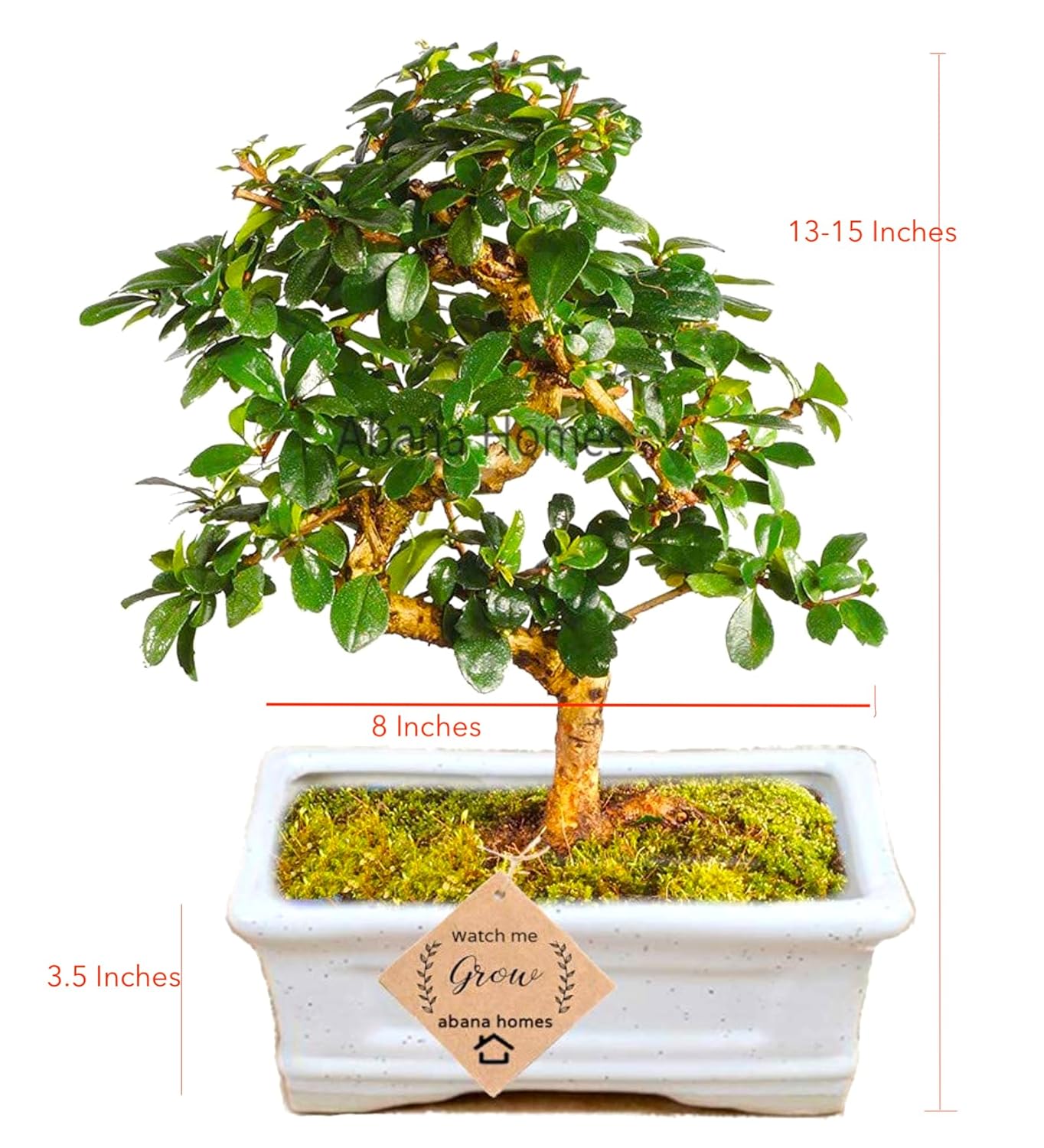Imagine a world where huge trees are turned into tiny marvels, standing still and adding beauty to our homes. This is the magical world of bonsai, an ancient Japanese art of growing small trees. But why do these tiny trees capture the hearts of so many people around the world? Let's dive into the secrets of this enchanting art and discover its hidden beauty.

Key Takeaways
- Bonsai is the Japanese art of growing miniature trees in small containers.
- The practice combines horticulture, design, and patience to create living works of art.
- Bonsai trees are carefully pruned and trained to maintain their diminutive size and unique shapes.
- Bonsai reflects the natural forms found in the wild, capturing the essence of the natural world.
- This ancient art form has a rich cultural heritage and global following.
Introduction to Bonsai
Bonsai is a fascinating art that has been loved in Japan for a long time. It involves growing tiny trees in pots. These trees are shaped and trained to look like full-sized trees. Bonsai is more than just growing plants; it's a mix of art, patience, and nature.
What is Bonsai?
Bonsai is about growing miniature trees in pots. These trees are chosen, pruned, and trained to look amazing. They are not changed genetically; they are grown small and shaped through careful gardening.
History and Cultural Significance
The start of bonsai is in ancient Chinese gardening. But Japan made it into a special art form. In Japan, bonsai trees mean harmony, patience, and a deep bond with nature.
"Bonsai is the living art of miniature trees, where the gardener's vision and the tree's potential combine to create a work of art that transcends time and space."
People all over the world love bonsai. They spend their lives learning and growing these tiny trees. From old Japanese styles to new ones, bonsai keeps inspiring and exciting people everywhere.
The Art of Pruning Bonsai
Bonsai is the art of growing tiny trees. It's all about balance between growth and control. Pruning is key, shaping the tree's look.
Pruning is more than just cutting off extra parts. It's a dance, where each cut helps the tree grow better. By choosing which branches to cut, artists guide the tree's shape.
Mastering Pruning Techniques
Pruning bonsai needs a deep understanding of the tree's growth. Artists use special tools to shape their trees. These tools help create beautiful, detailed designs.
| Pruning Technique | Purpose |
|---|---|
| Branch Thinning | Removing unnecessary branches to promote airflow and light penetration |
| Leaf Pruning | Selectively removing leaves to enhance the bonsai's aesthetic appeal |
| Root Pruning | Trimming roots to maintain the plant's proportions and encourage ramification |
Good pruning keeps bonsai healthy and beautiful. With practice, bonsai artists can make their trees into stunning works of art.
"Bonsai is not just about growing a small tree; it's about creating a living work of art."
Bonsai Pots and Containers
The container for a bonsai is key to its growth and look. Bonsai lovers pick pots that match the tree's size, shape, and style. They also repot the bonsai every few years to keep it healthy.
Choosing the Right Pot
Finding the perfect pot for a bonsai is an art. Artists think about the tree's species, size, and shape. They also consider the pot's material, color, and design to match the bonsai's look.
Repotting Techniques
Repotting a bonsai regularly is important for its growth. This means taking it out of its pot, trimming the roots, and putting it in a new potting mix. Doing this right helps the bonsai thrive in its small space.
Choosing the right pot and repotting well keeps bonsai trees healthy and beautiful. This follows the art of bonsai closely.
Seasonal Care for Bonsai
Caring for bonsai trees means knowing their special needs by season. As the weather changes, bonsai lovers must adjust their care. This ensures these small wonders stay healthy and beautiful.
Spring Care
In spring, bonsai owners focus on pruning, fertilizing, and repotting. Pruning keeps the bonsai's shape and size right. Fertilizing gives them the nutrients they need for strong growth.
Repotting, done every 2-3 years, gives the bonsai fresh soil to grow in. This is key for their health.
Summer Care
Summer brings warmer weather, changing bonsai care to watering, shaping, and protecting. Bonsai trees dry out fast because of their small roots. So, they need careful watering.
Shaping the bonsai keeps it looking good. Techniques like wiring and pinching help. This is important in summer.
Protecting bonsai from too much sun is also key in summer. Using shade or sun filters keeps leaves from burning. This keeps the bonsai's leaves bright and healthy.
Learning how to care for bonsai through the seasons is crucial. Knowing their needs helps gardeners grow and keep beautiful bonsai collections.
Indoor Bonsai Cultivation
Many bonsai species can grow well indoors, making them great for city living. To keep your indoor bonsai healthy, you need to control the lighting, temperature, and humidity carefully.
Choosing the right bonsai for indoors is key. Chinese Elm, Ficus, and Japanese Juniper are good choices. They add beauty to your space with their leaves and branches.
Getting the right lighting is vital for your indoor bonsai. A sunny window or a grow light can help. Also, keep the temperature between 65-75°F (18-24°C).
Keeping the humidity right is also important. Use a pebble tray or humidifier to keep the air moist. With proper care, your indoor bonsai will thrive and enhance your home.
"The art of growing bonsai is not just about creating miniature trees, but about finding harmony between nature and our living spaces."
| Bonsai Species | Lighting Requirements | Temperature Range | Humidity Needs |
|---|---|---|---|
| Chinese Elm | Bright, indirect light | 65-75°F (18-24°C) | Moderate to high humidity |
| Ficus | Bright, direct light | 70-85°F (21-29°C) | High humidity |
| Japanese Juniper | Bright, direct light | 55-75°F (13-24°C) | Moderate humidity |
Bonsai Styles and Aesthetics
The art of bonsai is loved for its many styles and beauty. It ranges from traditional Japanese forms to modern designs. Each style offers a special look that draws in fans and viewers.
Traditional Japanese Bonsai Styles
Traditional Japanese bonsai styles mimic trees growing in nature. Styles like upright, slanting, and cascade show the beauty and strength of small trees. Artists carefully shape and train the plants to create these iconic looks.
This art form brings peace and a connection to nature.
Contemporary Bonsai Designs
Modern designers have also made their mark on bonsai. They use new shapes, angles, and compositions. This mix of old and new brings a fresh view to the art of small trees.
| Bonsai Style | Description | Visual Appeal |
|---|---|---|
| Upright | A symmetrical, vertical form that mimics the natural growth of a tree. | Elegant and stately, conveying a sense of stability and strength. |
| Slanting | A dynamic style with the trunk and branches growing at an angle, often toward the light. | Expressive and dynamic, evoking a sense of movement and energy. |
| Cascade | A graceful style with the branches and foliage cascading downward, mimicking a waterfall. | Serene and flowing, evoking a sense of tranquility and natural beauty. |
Bonsai's variety lets fans create stunning, unique trees. Each tree is a special piece of art.

The Patience and Dedication Required
Mastering bonsai art needs a lot of patience and dedication. These small trees can take years or decades to grow fully. Keeping them healthy and looking good is a never-ending job. Bonsai lovers must be ready to spend a lot of time pruning, watering, and caring for their trees over the long term.
Bonsai is not easy. It needs a mix of gardening skills, artistic talent, and constant dedication. People who love bonsai must be ready to spend hours shaping and looking after their trees. They must always change their care methods to keep the tree alive and beautiful.
"Bonsai is not just a hobby; it's a way of life. It requires a level of patience and commitment that few other pursuits can match."
The best part of bonsai is the slow, careful growth over years or decades. This long-term commitment makes bonsai special. It turns it into a rewarding and enriching hobby for those who really get into it.
Whether you're already into bonsai or just starting, the journey is filled with patience and dedication. From the detailed pruning to the careful watering, every part of bonsai needs a lot of attention. This can only come from a true love for these amazing small trees.
Bonsai as a Cultural Tradition
The art of bonsai is deeply rooted in Japanese culture. It has been practiced for centuries as a revered form of artistic expression. The intricate techniques and aesthetic principles of bonsai are inextricably linked to Japanese traditions and philosophies, such as Zen Buddhism and the profound appreciation of nature.
Japanese Bonsai Art
In Japan, the cultivation and care of bonsai trees are considered a refined art form. It is imbued with a spiritual significance that transcends mere horticulture. The meticulous pruning, shaping, and training of these miniature trees are seen as a reflection of the Japanese reverence for harmony, balance, and the delicate beauty of the natural world.
Global Spread and Appreciation
Over the past few decades, the art of bonsai has gained global recognition and popularity. Enthusiasts around the world cultivate and appreciate these captivating miniature trees. The cultural significance and universal appeal of bonsai continue to inspire and captivate people from diverse backgrounds, who are drawn to the meditative practice and the exquisite aesthetics of this unique Japanese art form.
"Bonsai is not just about growing miniature trees; it's about cultivating a deeper connection with nature and finding harmony within oneself."
As the global appreciation for bonsai continues to grow, the legacy of this centuries-old cultural tradition is being shared and celebrated across borders. It inspires a new generation of enthusiasts to embrace the art of bringing the natural world into their own living spaces.

Bonsai Tools and Supplies
The art of bonsai needs special tools and supplies. Bonsai lovers use pruning shears, concave cutters, wire, and more. They also pick the right pots, soil, and fertilizers for their trees.
Getting the right tools and supplies is key for bonsai growers. Let's look at what you need to create and care for these tiny trees.
Essential Bonsai Tools
- Pruning Shears: Sharp shears for cutting and shaping branches and leaves.
- Concave Cutters: Tools for making clean cuts on thick branches, helping them grow well.
- Bonsai Scissors: Fine scissors for detailed trimming of leaves and twigs.
- Wire Cutters: For applying and removing wire to shape the bonsai.
- Root Hooks: Curved tools for untangling and arranging the bonsai's roots.
Bonsai Pots and Soil
Choosing the right bonsai pot and soil mix is vital. Bonsai pots vary in shape, size, and material. A good soil mix, with organic matter, helps bonsai trees grow well.
| Bonsai Pot Material | Soil Mix Components |
|---|---|
| Ceramic | Akadama, Pumice, Compost |
| Glazed | Lava Rock, Sand, Peat Moss |
| Unglazed | Turface, Bark Chips, Decomposed Granite |
Having the right tools and supplies is crucial for bonsai care. With the right equipment, bonsai lovers can keep their trees healthy and beautiful.
Bonsai for Beginners
Bonsai might seem tough at first, but it's rewarding for beginners. Learning to water, prune, and repot is key. These skills are the foundation for growing bonsai.
Getting Started
Start by learning the basics of bonsai. Discover the various species and their needs. Know about soil, fertilizers, and sunlight.
With patience and a desire to learn, you'll grow well. You'll become a skilled bonsai grower.
Choosing Your First Bonsai
Picking the right bonsai is important. Think about your climate, sunlight, and preferences. Chinese Elm, Juniper, and Ficus are good for beginners.
Choose a healthy plant with strong roots and balanced growth. Avoid complex species at first. With the right bonsai and care, you'll create a beautiful miniature.
"The true essence of bonsai is not found in the end product, but in the patience and dedication required to achieve it."
Conclusion
The art of bonsai is a mix of Japanese tradition, gardening skill, and creativity. It involves growing and shaping small trees into living art. This art shows the beauty and balance of nature.
Every bonsai is a result of patience, hard work, and creativity. The grower uses special pruning, pots, and containers. These details show the grower's dedication and skill.
The aesthetic appeal of bonsai trees is clear, with their elegant shapes and fine leaves. They attract people everywhere. But, bonsai also carry deep cultural meaning, showing the lasting traditions of Japanese art and gardening.
Whether you're an expert or just starting, bonsai's timeless charm is captivating. It inspires and delights everyone who sees it.
Bonsai's popularity is growing worldwide. People enjoy them in gardens, galleries, and shows. This shows our ongoing love for nature and beauty in small things.
So, let's keep being amazed by the world of bonsai. It's a journey of discovery, one tree at a time.
FAQ
What is Bonsai?
Bonsai is the ancient Japanese art of growing small trees in pots. These plants are pruned to look like full-sized trees.
What is the history and cultural significance of Bonsai?
Bonsai started in ancient China but became a big deal in Japan. It's not just pretty; it also shows patience and a love for nature.
How important is pruning in Bonsai?
Pruning is key in bonsai. It helps shape the trees into miniatures. Artists use special tools to keep the trees looking right.
What role do pots and containers play in Bonsai?
The pot is important for the tree's look and health. Artists pick pots that match the tree's style. They also need to repot the tree right.
How do Bonsai trees need to be cared for throughout the seasons?
Bonsai trees need special care all year. In spring, they get pruned and fertilized. Summer is for watering and protecting them from stress.
Can Bonsai trees be grown indoors?
Yes, many bonsai trees can grow indoors. They need the right light, temperature, and humidity to thrive.
What are the different styles and aesthetics of Bonsai?
Bonsai has many styles, from traditional to modern. Traditional styles show how trees grow naturally. Modern styles are more creative.
What kind of patience and dedication is required for Bonsai?
Bonsai needs a lot of patience and dedication. It can take years for a bonsai to grow. Caring for them is a long-term commitment.
How is Bonsai connected to Japanese culture?
Bonsai is a big part of Japanese culture. It's tied to Zen Buddhism and loving nature. The art of bonsai is deeply rooted in Japanese traditions.
What kind of tools and supplies are needed for Bonsai?
Bonsai needs special tools and supplies. These include pruning shears and pots. The right tools and supplies help the bonsai grow well.
How can a beginner get started with Bonsai?
Starting bonsai can seem hard, but it's rewarding. Beginners should learn the basics of watering, pruning, and repotting. Choosing the right tree is also important.



















